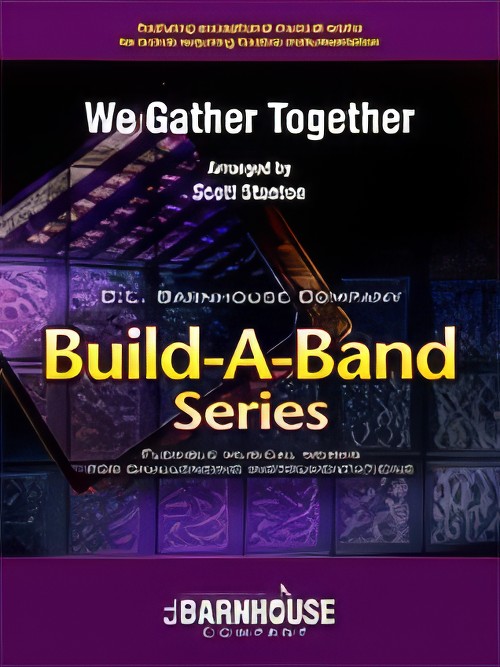Results
-
 £82.50
£82.50Bravura - Robert E. Foster Jr.
This famous circus march has been a favorite of bands and audiences for years, and this well-crafted arrangement puts it easily within the reach of less experienced musicians. It will sound great with young players and provide a thrilling march addition to concert or contest programs. The solid and well-doubled scoring will sound impressive on any program and will provide the same feeling of excitement as the original.
Estimated dispatch 7-14 working days
-
 £80.95
£80.95Fantasia for Christmas
From its quiet opening through its grand and sweeping cascades of sound, this very familiar seasonal carol experiences a complete and powerful transformation. The use of brilliant metal percussion complements the massive peaks of sound from the winds. This scoring is guaranteed to leave your audiences breathless. The holiday concert closing selection. (3:19)
Estimated dispatch 7-14 working days
-
 £60.00
£60.00We Gather Together (Flexible Ensemble - Score and Parts) - Kremser, Eduard - Stanton, Scott
The famous Dutch hymn "We Gather Together" is scored for small bands with limited instrumentation, but will sound great with bands of all sizes! Dedicated to the Frontline Responders and Essential Workers who keep us safe, this is the perfect "welcome back" piece for both the band and your returning audience. With "Build-A-Band scoring, you get to create unique sounds using the strengths of your instrumentation, and by following the suggested flexible interplay between sections. This beautiful arrangement includes optional vocal parts for performers and/or audience. Piano, bass, guitar and percussion can strengthen your sound as well. Flexible works wonders, and it's perfect for distance learning situations! Duration: 3.30
Estimated dispatch 7-14 working days
-
 £60.00
£60.00BANDOLOGY (Easy Concert Band) - Osterling, Eric
Here's an outstanding march that many of us grew up with, and now younger players can enjoy it too! And best of all, Eric Osterling's rescoring at this easier level still sparkles just as much as the original! The colorful harmonies and spirited melodies still sound fresh today, and Bandology offers an excellent alternative to the traditional march sound. A real winner! Grade: medium easy
Estimated dispatch 7-14 working days
-
 £41.58
£41.58Nighthawk (Concert Band - Score and Parts)
A slow, dark, and mysterious theme serves as a prelude to a new section that explodes with rhythmic energy. Instruments scored where they sound their best, layered themes, interesting harmonies, and a variety of percussion parts all combine to create an exciting musical journey from start to finish. The crafting of this piece will help make your students sound advanced for their age. Very Impressive!
Estimated dispatch 7-14 working days
-
 £44.55
£44.55Now The Winter's Come To Stay
Very lyrical and expressive, this peaceful David Shaffer composition is a wonderful tool for teaching legato style to mid-level groups. Carefully scored to assure a lush full sound and help your band attain a more mature sound. Written in the style of a chorale prelude, it will make a great change of pace selection for any winter or holiday concert. Very Highly recommended!
Estimated dispatch 7-14 working days
-
 £56.99
£56.99Nighthawk - James Swearingen
A slow, dark, and mysterious theme serves as a prelude to a new section that explodes with rhythmic energy. Instruments scored where they sound their best, layered themes, interesting harmonies, and a variety of percussion parts all combine to create an exciting musical journey from start to finish. The crafting of this piece will help make your students sound advanced for their age. Very Impressive!
Estimated dispatch 7-14 working days
-
£65.99
And Now, The Band! - Webb
"And Now, The Band!" by Amy Webb puts into play all those concepts you've been teaching your first-year band: articulation, dynamics, crescendos/decrescendos - the list of goes on and on, and they're all here! Designed as a showpiece of everything your young musicians have learned this year, they will sound like a million bucks at your next concert! Excellent as a concert opener, closer, or anywhere - band kids will certainly sound impressive with this exciting piece! Ladies and gentlemen, "And Now, The Band!" A real winner!
Estimated dispatch 7-14 working days
-
£76.99
We Gather Together - Kremser
The famous Dutch hymn "We Gather Together" is scored for small bands with limited instrumentation, but will sound great with bands of all sizes! Dedicated to the Frontline Responders and Essential Workers who keep us safe, this is the perfect "welcome back" piece for both the band and your returning audience. With "Build-A-Band scoring, you get to create unique sounds using the strengths of your instrumentation, and by following the suggested flexible interplay between sections. This beautiful arrangement includes optional vocal parts for performers and/or audience. Piano, bass, guitar and percussion can strengthen your sound as well. Flexible works wonders, and it's perfect for distance learning situations!
Estimated dispatch 7-14 working days
-
 £54.99
£54.99Miles Ahead - Jay Taylor
This selection for first-year bands was carefully written to sound full and mature, giving young players confidence and impressing audiences that a young band can sound so mature and accomplished. Not only will it have your group sounding miles ahead of their age and experience, it will give them a glimpse of the future and the many great musical moments they have waiting for them in the miles ahead.
Estimated dispatch 7-14 working days
